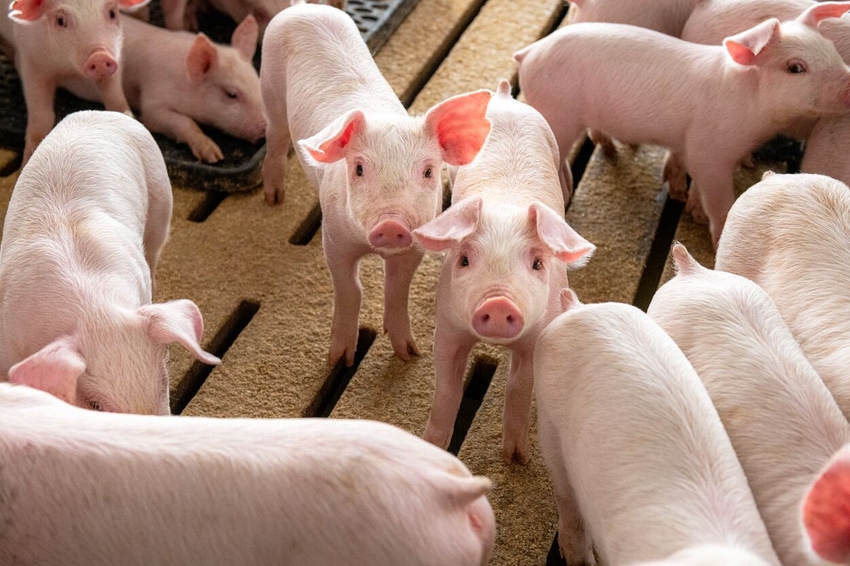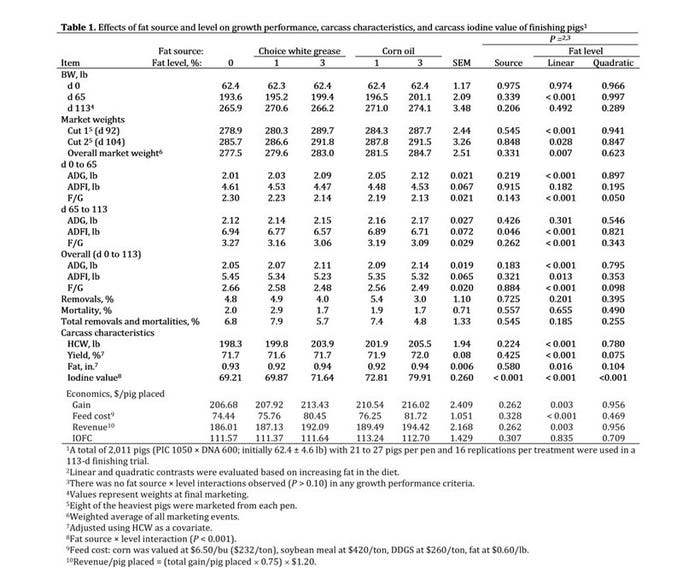Fat level and source for finishing pigs
Evaluating for growth, carcass characteristics, carcass iodine value and economics in a commercial environment.
March 9, 2023

Supplementing finishing diets with added fat has been known to reduce average daily feed intake, increase average daily gain, and improve feed efficiency. There are various fat sources that can be used in swine diets, all that contain different digestibility and energy values.
Animal fats contain more saturated fatty acids with lower digestibility and energy concentrations compared to vegetable oils, which are higher in unsaturated fatty acids. Also, the different fatty acid compositions from alternative fat sources can impact carcass characteristics and carcass iodine value differently.
Feeding diets containing vegetable oils increases the amount of polyunsaturated fatty acids in the fat, which therefore, increase iodine values compared to pigs fed diets containing animal fats. Additional research is needed to understand the impact of different fat sources and inclusion levels on growth performance and economic return of modern swine genetics, especially with the increased cost of fat that is realized today.
Therefore, the objective of this study was to evaluate the effects of two different fat sources, choice white grease or corn oil, fed at two different levels on growth performance, carcass characteristics, carcass iodine value, and economics of finishing pigs reared in a commercial environment.
Procedures
This experiment was conducted at a commercial research facility located in southwest Minnesota (Pipestone Nutrition; Edgerton, Minnesota). Pigs were placed and housed in a temperature-controlled wean-to-finish facility. Each pen (22.4 × 8.3 ft) contained one nipple waterer and a four-hole dry self-feeder to allow for ad libitum access to feed and water. Pigs were allowed approximately 6.9 ft2/pig.
Animal treatment and structure
A total of 2,011 pigs (PIC 1050 × DNA 600; initially 62.4 ± 4.6 lb) were used in a 113-day finishing trial. There were 21 to 27 pigs per pen and 16 pens per treatment. On d 0, pens were blocked by location in the barn and randomly allotted to one of five dietary treatments. A similar number of barrows and gilts were placed in each pen. Dietary treatments were arranged in a 2 × 2 +1 factorial with main effects of fat source and fat level. Dietary treatments included a control diet containing no added fat. The other four dietary treatments included two different fat sources, choice white grease or corn oil, added at 1 or 3% of the diet. Pens of pigs and feed disappearance was measured on d 0, 13, 31, 50, 65, 78, 93, 105 and 113 to determine ADG, ADFI and F/G.
On d 92 and 104, eight of the heaviest pigs per pen were weighed individually and transported to a commercial packing plant (WholeStone Farms, Fremont, Nebraska) for processing and determination of carcass characteristics. The remaining pigs were marketed at the conclusion of this trial on d 113 and transported to WholeStone Farms for collection of carcass characteristics. A fat sample that included all three layers of fat was taken from the belly from one barrow per pen per marketing event. Iodine value analysis was conducted using near-infrared spectroscopy at WholeStone Farms.
Diet preparation
Experimental diets were fed in six different phases.Pigs were fed on a feed budget with phase 1, 2, 3, 4 and 5 provided at 38, 91, 102, 107 and 90 lb per pig, respectively. Phase 6 was provided for the remainder of the study. All nutrients were formulated to meet or exceed NRC requirement estimates. All diets were a corn-soybean meal-based and were fed in meal form.
Economic analysis
For economic analysis, gain per pig placed, total feed cost per pig, revenue, and income over feed cost were calculated. Feed cost per lb of gain was calculated by dividing feed cost per pig by the total weight gained. Revenue per pig placed was determined by total gain times the dressing percentage (0.75) and then multiplied by a carcass price of $1.20. Margin over feed cost was calculated by using the revenue per pig placed minus the feed cost per pig placed. Choice white grease and corn oil was assumed to cost $0.60/lb.
Results and discussion
When looking at marketing weights, increasing fat in the diet from 0 to 3% led to a linear increase in BW for the first and second cut. Increasing fat also led to a linear increase in overall market weight.
There were no interactions between fat source and level for any growth performance response criteria. Thus, only main effects of fat source and level will be discussed. From d 0 to 65, increasing added fat from 0 to 3% in the diet increased ADG and improved F/G. There was no significant difference in ADFI observed during this period. There was also no main effect of fat source observed during this period.
From d 65 to 113, increasing added fat in the diet from 0 to 3% decreased ADFI and improved F/G. There were no significant differences in ADG or main effect of fat source observed during this period.

For overall growth performance (d 0 to 113), increasing dietary fat increased ADG, decreased ADFI, and improved F/G. Like the individual phase data, no differences between fat sources were observed. There were also no observed differences in removals, mortality, or total removals and mortalities over the duration of the study.
For carcass characteristics, increasing fat in the diet increased HCW and carcass yield. Increasing dietary fat from 0 to 3% also increased backfat. For carcass iodine value, there was a fat source × level interaction where iodine value increased linearly in pigs fed diets containing corn oil with only a small increase in iodine value when diets with choice white grease were fed.
For economics, increasing fat from 0 to 3% led to greater gain per pig placed and greater revenue. However, increasing added fat increased feed cost which led to no significant difference in IOFC.
In conclusion, increasing fat from 0 to 3%, regardless of fat source, increased overall ADG, reduced ADFI and improved F/G, regardless of fat source used. Increasing fat also increased HCW, carcass yield and backfat, while pigs fed diets containing corn oil had higher carcass fat iodine values. It is recommended that producers utilize their own current ingredient prices to compare economics of these dietary options.
You May Also Like



